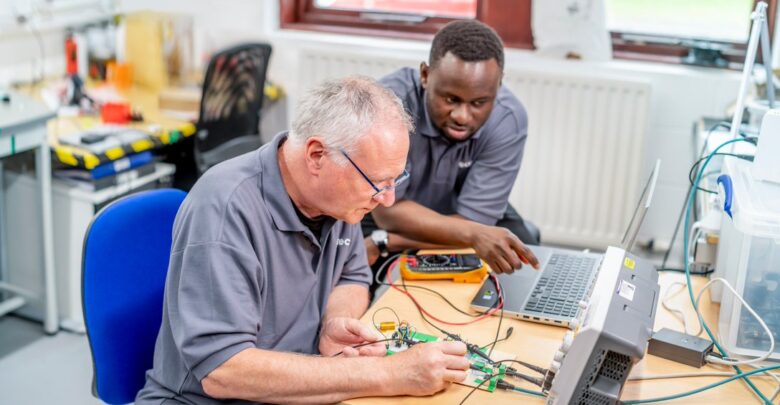
CREATEC’S first ten years in business – celebrated in June 2020 – is a lesson in how to successfully put entrepreneurialism and research and development at the heart of a company. Three members of Createc’s team share their stories
MATT Mellor started his career as an academic working in research and development at Oxford University.
His specialist field was in computer vision and robotics with medical application.
But in writing papers, which he says were mainly “read by other academics so they could cite it in their research”, Matt could see there was a vital component missing.
“To turn that research into a product I learned that you have got to make that happen yourself to ensure others recognise the value of it,” said Matt.
“That started me on an odyssey to learn about the full process of technological development.
“That means not just learning about technology, but also about business, people, finance – all the parts you need to make something happen which is going to make a positive change in the world.”
With that in mind Matt moved to Cumbria and joined REACT Engineering.
“REACT put the emphasis on entrepreneurship and I joined the company to apply what I had learned in nuclear medicine to nuclear engineering.”
In particular Matt was able to apply his knowledge in medical imaging to provide smart, technological solutions to the nuclear clean-up industry.
In 2007, Matt was the technical lead in setting up REACT’s own spin-out – aerial surveying company Hi-Def, which gave him valuable experience of the process involved in setting up a spin-out business.
Hi-Def went on to be a sustainable, successful business in its own right and in 2016 became part of the BioConsult SH group.
Matt meanwhile set up Createc in June 2010, and as CEO has led the company to achieve impressive growth.
Createc started out with just three members of staff – Matt, Alan Shippen and Pete Rodgers.
The company’s mission was to create a profitable business out of computer vision and robotics research and development, demonstrating the value such a service adds to industry.
Building on technological expertise in the nuclear sector learned from REACT Engineering, Createc developed its N-Visage® technology which was to be used in the clean-up following the Fukushima Daiichi accident in Japan.
Closer to home Createc used its intellectual property in computer vision to build a business opportunity and set up spin-out company Sportlight. Earlier this year, it added a second spin-out from its robotics expertise to create Createc Robotics.
Looking ahead, as society and industry move out of a Covid-19 lockdown, Matt sees robotics playing an ever more important role – but warns those who think it will be an overnight change, to be more patient.
“Society has always overestimated what technological development will take place over a two to five-year period. But it has always underestimated what development will take place over 20 years,” said Matt.
“Technological development is an accumulation of small goals which build on top of each other. It creeps forward so that over a 20-year period people then look back and are amazed at how much the world has changed.
“In 20 years time we are going to have a lot more robots, and we will have improved collaboration between human and machine.
“In some areas that might be helping to remove people from having to carry out tasks in hazardous environments. In other areas it might be giving people more senses and more capabilities.”
Createc applies its thinking and technologies to any problem to find a solution and takes a flexible approach to applying them – so they can be adapted for a range of industries and a range of situations.
“We look at the way we can do something, not where we can do it,” said Matt.
It’s an approach which has seen its solutions applied in a range of industries and settings, including nuclear and defence, rail and security. Among future growth areas for Createc are heavy engineering, major industrial and general construction.
Createc has received two Queen’s Awards in recent years, one for International Trade and one for Innovation, recognising the company’s success in developing technology.
The company has also won awards for innovation from The Institution for Engineering and Technology (IET), The International Atomic Energy Agency (IAEA) and Nuclear Decommissioning Authority (NDA).
Createc’s strategy as it moves beyond its 10-year anniversary is to concentrate on research and development to launch a series of further spin-out companies.
Two things Matt is keen to influence in the wider economy to help support the company’s ambitions involve funding and leadership.
“We need to make sure that the UK is more start-up friendly. And we need more entrepreneurs who want to come and run these businesses,” said Matt.
“To me an entrepreneur takes complete ownership and picks their way forward and proceeds confidently in the face of doubt.”
Createc is certainly proceeding with confidence.
Matt said: “We have had a sustained growth rate of 40 per cent, and we are focused on continuing to grow at this rate.
“In the first ten years we have grown from a company with three people turning over £180,000 to 30 people turning over £3.5m.
“To sustain that level of growth by the end of the next ten years we would have 300 people turning over more than £60m.”
Matt has a clear vision of how the company will keep driving forward, and his motivation and appetite to lead the company to further success is clear.
“My motivation comes from bringing something completely new to life which results in the world being a better place,” he said.
“Seeing all the pieces come together and creating this thing which creates an economic benefit and also has a positive impact on the world is really satisfying.”
For Matt and for Createc, the next ten years have already begun…
DAVID Clark was working in France as a gamma-ray astronomer involved in satellite missions when an online search alerted him to an opportunity at Createc.
He’d first gone to France in 2010 when the financial crisis meant investment was pulled from astronomy research and development projects in the UK. France offered better opportunities.
But one year later David was keen to return to Britain, so he did what many of us might do.
“I literally typed into Google, ‘gamma ray job in the UK’.”
And it worked!
“I saw a Facebook post by Matt Mellor who had set up this business called Createc in Cumbria and hurriedly sent my CV across,” said David.
“I came across for the interview and immediately knew it was what I wanted to do. The job role was ideal.”
It was early days for Createc. The company had only been set up in June 2010. It was spring 2011 and David had just become employee number four.
Before moving to France, David had been working on projects to transfer gamma-ray astronomy imaging technology to the nuclear security industry, and specifically working in industry/academic collaborations.
An expert in his field with an entrepreneurial drive to succeed, David’s work has resulted in more than 40 publications, receiving more than 1,500 citations.
He had also worked on international collaborations, to develop instrumentation and proposals for gamma-ray astronomy missions GRI, Dual and PheniX, and an astronomy collaboration to study the Supergiant Fast X-ray Transient objects and measure gamma-ray polarimetry.
David immediately bought in to Createc’s philosophy of focusing on solving a problem and making sure the solution was not industry specific.
The outcome is that Createc’s development work in its three core areas of imaging, sensing, and robotics is agile and flexible and can be applied to any situation in any industry.
So far Createc has enjoyed some of its biggest successes in nuclear, national security, rail, energy, manufacturing, aviation and the Ministry of Defence.
One of David’s first roles at Createc was working on technology to be used by the Home Office for baggage scanning.
“The challenge was to develop a baggage scanner which could accurately and quickly identify baggage contents, to check, for example, not just that there was a bottle inside a bag, but to identify what liquid was inside that bottle.
“It could also identify whether a battery was actually a normal battery, or whether it was in fact an explosive.”
Today David is the Operations Director for Createc, supporting company founder and CEO Matt Mellor in running the business.
David leads the development and implementation of Createc’s project management system, while continuing to manage key projects in the company’s main research team.
“By being a small company – now employing 30 people – we are able to be agile and do some really cool stuff.
“There’s a lot of energy across the business and a real ‘can do’ attitude. We’ve got the freedom to work out solutions to problems and make fast progress on projects.”
David can pinpoint the moment Createc developed its N-Visage® technology as a game-changer for the business.
“There was a big transformation after the Fukushima Daiichi accident happened (in March 2011).
“Before that we were a small group of people coming up with great ideas.
“After Createc attended the UK nuclear industry trade mission to Japan, we were able to show that our technology – specifically our N-Visage® system that we developed – could really help people
“All of a sudden we were more than a research and development group, we were able to go out and make a positive difference in society.
“From that point we have developed more and more capability.”
David has been involved in developing the concrete depth profiling technology D:EEP with the help of InnovateUK and Nuclear Decommissioning Authority (NDA) grants plus a collaboration with Costain.
David has also been involved in developing several new technologies for Createc including a motion tracking technology for the Ministry of Defence’s Sensing for Asset Protection with Integrated Electronic Networked Technology (SAPIENT) programme. David now represents Createc on the MoD’s SAPIENT Interface Management Panel.
The SAPIENT technology he has helped develop has resulted in Createc’s first spin-out company Sportlight which is developing the world’s most advanced sports analytics engine to revolutionise sports science and sports analytics.
Sportlight uses cutting edge, military-grade technology, developed by Createc, to provide hyper-accurate, relevant and rich intelligence to professional sports teams.
David said: “I’m really proud of what the Createc team achieve. Every time I stand up at a conference and tell everyone who we are and what we do I feel proud. People always come up afterwards and say: ‘wow, that’s really impressive’.
“It reminds me why we are here. It’s having a core idea, developing it, and applying it to provide a solution to a real-world problem and solving human challenges.”
David is also delighted he chose to make the move to Cumbria. “My wife Emma is from North Wales and although I am from Fareham, near Portsmouth, I like the outdoor life and we thought Cumbria would be a good place to bring up a family.”
Children Thomas, aged seven, and Isabella, aged four, agree. Both enjoy trips to the office, especially if it means they get to see robotics and VR controllers.
David said: “Createc does a lot of work to inspire young people into science, engineering and technology careers.
“Having companies like Createc here shows that Cumbria is far from being a backwater when it comes to high-tech companies.
“It’s a beautiful place where we can do a lot of cool high-tech research and development and solve human challenges.”
Looking ahead, David has his sights set on the acceleration of further Createc success and more spin-out companies.
“Now is the perfect time to focus on the future. I can see us really start to accelerate and grow into an internationally recognised and respected, community of companies.
“We have got the right people with the right mindset and the right capabilities to be able to go and achieve that.”
WHEN he was at a loose end during a break from university Ben Chaudhri walked around his local business park and knocked on the door of Createc to see if they had any opportunities.
Five years later he’s the CEO of Createc’s latest spin-out Createc Robotics.
If you think Ben’s name rings a bell. You’d be right. He was on the famous Wolfson College Cambridge University Challenge finalist team of 2017 captained by Eric Monkman.
Ben graduated from Cambridge last year with a Masters in Engineering, and joined Createc full-time in September.
He’s had plenty of experience with the company during his time as an undergraduate.
That first knock on the door at Createc’s offices at Cockermouth in Cumbria led him to work there for six months.
He was recovering from a spinal operation at the time and wanted “something to do, something science and technology related but there weren’t many places I could think of which might offer that sort of opportunity,” said Ben.
He landed on his feet at Createc. That’s exactly what they do.
Createc creates technologies which solve some of the world’s most challenging problems.
They are behind some of the world’s most advanced nuclear and sensing technologies.
With two Queen’s Awards to their name – the team is motivated by, and focused on, using their scientific and engineering skills to have a positive impact on society, both locally and globally.
It’s an ideal fit for Ben.
After his initial spell at Createc, the following summer the company funded Ben on a laboratory-based research placement at Cambridge.
Ben was enjoying the type of work Createc are involved in.
“Createc are strong on fundamental science. But they are also strong in translating theoretical research into getting things done in reality.
“Instead of research which could just gather dust in some academic journal, it’s about making sure that research is applied to solving problems in the real world and is actually helping people.
“Being part of that is exciting. I like to be doing things which make a difference” said Ben.
In 2017 and 2018 Ben helped Createc set up its Oxford office and worked on Createc’s Elephants to Ants robotics technology concept for software to enable non-experts to operate, deploy, and reconfigure robotics systems which could be used for nuclear decommissioning and other industrial operations.
The Elephants to Ants concept won £1.5m funding to develop it as part of the UK government’s Integrated Innovation in Nuclear Decommissioning (IIND) competition. The project culminated in September 2019 with a successful multi-robot system demonstration held at the UK Atomic Energy Authority’s (UKAEA) RACE facility at Culham in Oxfordshire.
In February 2020 Ben was appointed CEO of Createc’s new Oxford-based spin-out Createc Robotics which aims to commercialise Iris, Createc’s robotics technology developed through its Elephants to Ants programme.
Ben is passionate about the ethos and values of Createc, as well as what the company achieves.
“I like the white heat of new technology. But also the people are all really great to work with. It’s a small company punching above its weight, doing really innovative work.”
Now Ben, is looking forward to the next chapter, and leading Createc Robotics into a bright new future.






